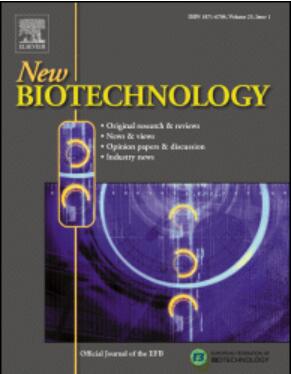Prenylation of diverse indole derivatives by the fungal aromatic prenyltransferase RePT
IF 4.9
2区 生物学
Q1 BIOCHEMICAL RESEARCH METHODS
引用次数: 0
Abstract
Prenylation is a widespread natural modification of compounds that serves to functionalize and often enhance the bioactivity of plant and microbial secondary metabolites, including indole derivatives. In this study, we aimed to expand the library of prenylated indoles using RePT, a fungal (i.e. Rasamsonia emersonii) aromatic prenyltransferase from the dimethylallyl tryptophan synthase (DMATS) family. Previous work showed that RePT readily C7- and N1-prenylated l-tryptophan, and O-prenylated l-tyrosine and a number of phenolic stilbenes. Here, we investigated its regioselectivity further with 23 indole substrates, including tryptophan derivatives with varying C4-C7 substituents and several C3-substituted indoles. High conversion was observed primarily with fluorinated tryptophans and unsubstituted indole. Product analysis by UHPLC-PDA-ESI-MSn and NMR revealed that RePT mainly catalyzed either normal prenylation at C7 or reverse prenylation at N1 on a series of halogenated tryptophans. The regioselectivity observed for several substrates was strongly influenced by the position of the halogen substituent, particularly fluorine, which displayed its characteristic ortho-/para-directing effect. In the absence of the amino acid moiety, RePT’s regioselectivity in some cases shifted from its typical preference, leading to prenylation at alternative positions such as C3 and C6. These findings showcase the versatility of RePT for modifying diverse indole derivatives and demonstrate, for the first time, halogen-induced steering of the regioselectivity of DMATS to facilitate synthesis of bioactive prenylated compounds and intermediates.
真菌芳香戊烯基转移酶RePT对多种吲哚衍生物的戊烯化反应。
戊酰化是一种广泛的天然修饰化合物,用于功能化和增强植物和微生物次生代谢产物的生物活性,包括吲哚衍生物。在这项研究中,我们旨在利用真菌(即Rasamsonia emersonii)芳香戊烯基转移酶RePT(来自二甲基烯丙基色氨酸合成酶(DMATS)家族)扩展戊烯基化吲哚库。先前的研究表明,RePT易于C7-和n1 -烯丙基化l-色氨酸,o -烯丙基化l-酪氨酸和一些酚类二苯乙烯。在这里,我们进一步研究了23个吲哚底物的区域选择性,包括具有不同C4-C7取代基的色氨酸衍生物和几种c3取代的吲哚。观察到高转化率主要与氟化色氨酸和未取代吲哚。UHPLC-PDA-ESI-MSn和NMR分析表明,RePT主要催化一系列卤代色氨酸的C7位正戊烯酰化和N1位反戊烯酰化。几种底物的区域选择性受到卤素取代基位置的强烈影响,特别是氟,表现出其特有的正定向/准定向效应。在缺乏氨基酸片段的情况下,RePT的区域选择性在某些情况下改变了其典型的偏好,导致在C3和C6等替代位置发生戊烯酰化。这些发现展示了RePT修饰多种吲哚衍生物的多功能性,并首次证明了卤素诱导的DMATS区域选择性的导向,以促进生物活性戊烯基化化合物和中间体的合成。
本文章由计算机程序翻译,如有差异,请以英文原文为准。
求助全文
约1分钟内获得全文
求助全文
来源期刊

New biotechnology
生物-生化研究方法
CiteScore
11.40
自引率
1.90%
发文量
77
审稿时长
1 months
期刊介绍:
New Biotechnology is the official journal of the European Federation of Biotechnology (EFB) and is published bimonthly. It covers both the science of biotechnology and its surrounding political, business and financial milieu. The journal publishes peer-reviewed basic research papers, authoritative reviews, feature articles and opinions in all areas of biotechnology. It reflects the full diversity of current biotechnology science, particularly those advances in research and practice that open opportunities for exploitation of knowledge, commercially or otherwise, together with news, discussion and comment on broader issues of general interest and concern. The outlook is fully international.
The scope of the journal includes the research, industrial and commercial aspects of biotechnology, in areas such as: Healthcare and Pharmaceuticals; Food and Agriculture; Biofuels; Genetic Engineering and Molecular Biology; Genomics and Synthetic Biology; Nanotechnology; Environment and Biodiversity; Biocatalysis; Bioremediation; Process engineering.
 求助内容:
求助内容: 应助结果提醒方式:
应助结果提醒方式:


